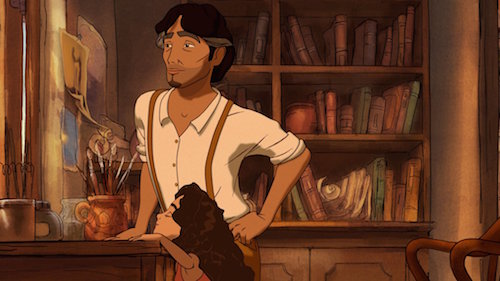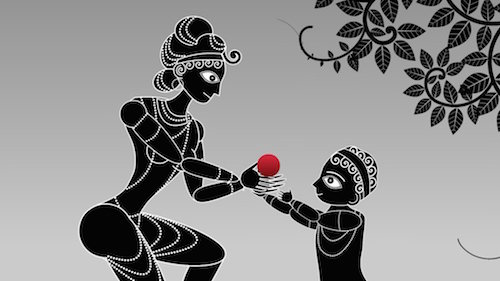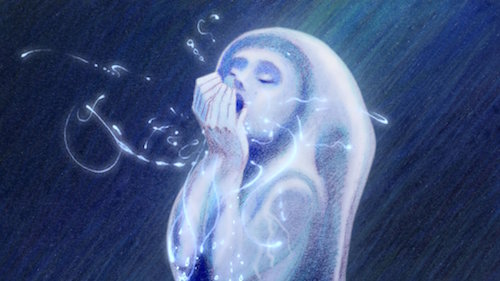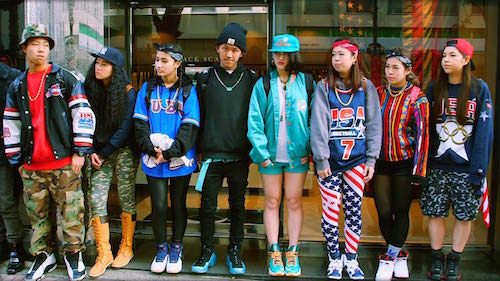Inspirational Animation and Serious Sneaker Obsession

Courtesy of Gkids
Even in a field of distinctive and cutting-edge animated films, Kahlil Gibran’s The Prophet is unusual. Directed by Roger Allers (The Lion King), the long-gestating passion project of producer Salma Hayek features the work of eight international independent animators, in addition to Allers’ crew. Though constructed as a children’s tale, the film contains sophisticated animated segments inspired by chapters from Lebanese poet Gibran’s much-quoted guide to philosophical and spiritual enlightenment. The framing story’s simplistic narrative and overly broad humor, presented in traditional (if not actually hand-drawn) animation style, is somewhat at odds with its dark political overtones, adding to the disconnect. Despite its flaws, however, The Prophet — buoyed by a diversity of splendid animation — becomes surprisingly poignant by its conclusion.

Courtesy of Gkids
Very loosely based on its source and set in a vaguely Middle Eastern land, the narrative involves a rambunctious little girl whose mother (voiced by Hayek) cleans the rooms of a poet (Liam Neeson), imprisoned for seven years due to his inflammatory writing. One day he is told that he will be released to return to his own country, but the authorities — autocratic bad guys (Alfred Molina, Frank Langella) — aren’t exactly truthful. While young children might not understand the film’s themes of censorship, artistic freedom and tyrannical political regimes, older kids will probably be put off by the story’s naive presentation. (There’s also the distracting matter of ostensibly Arabic characters voiced by actors with Spanish, Irish and American accents.) But all is forgiven every time the story gives way to one of Gibran’s poetic essays, each a distinctive animation either sonorously narrated by Neeson or — in two instances — sung plaintively: Damien Rice’s “On Children,” which underscores Nina Paley’s trippily psychedelic segment and “On Love,” Lisa Hannigan and Glen Hansard’s lovely duet for Tomm Moore’s elaborate, swirling clip.

Courtesy of Gkids
In addition to those animated chapters, the film features Bill Plympton’s simple, pencil-drawn “On Eating and Drinking”; Michal Socha’s lovely, inventive “On Freedom”; Joann Sofar’s sexy tango “On Marriage”; Joan Gratz’s flowing, painterly “On Work”; the delicate watercolors of Mohammed Saeed Harib’s “On Good and Evil” and the Brizzi brothers’ elegant, old-school “On Death.”
Though uneven, The Prophet is ultimately a visually stunning homage to one of the 20th century’s most influential books and its author.
Kahlil Gibran’s The Prophet is playing at Landmark Sunshine Cinema.
From the sublime to …?
Sneakerheadz, a documentary by David T. Friendly and Mick Partridge, is a mostly lighthearted look at the phenomenon of grand-scale sneaker collecting. Though the film includes interviews with designers, collectors, resellers and pop culture pundits, the obsession with amassing countless shoe styles — most never to be worn — will likely remain a mystery to anyone who isn’t part of the culture. Needless to say, sneakerheads themselves will probably be all over this.
Through talking heads such as Sneakerology retailer Jeff Elliott, designer Frank the Butcher, and rapper/collector Wale, the film traces the rise of kicks culture, the result of popular culture’s embrace of hip hop, sports and street styles. (Of course there’s a nod to Run DMC and the hit “My Adidas.”) Sneaker celebs such as Jeff Staple, whose collab with Nike resulted in the hugely popular Pigeon Dunk (2005), and influential Japanese boutique owner Hommyo Hidefuni are featured prominently, in addition to high-profile collectors like MLB pitcher Jeff Guthrie, who houses his stash in a fancy vault named Fort Knox and confesses that his obsession’s demands can get overwhelming. We also see Carmelo Anthony admitting, “I stopped counting after 1,000.”
Though mainly a guy thing, a couple of women are included, notably DJ Samantha Ronson, who gazes fondly at a photo album of the collection she keeps in storage. The resale value of limited editions such as the Nike Dunk Low “Paris” (several thousand dollars) is pretty impressive, with Michael Jordan’s “flu game” shoes (worn during the 1997 NBA finals) selling at auction for nearly $105,000 a couple of years ago.
The dark side of all this — violence erupting among crowds awaiting a new release and kids getting beaten or killed for their kicks — is touched upon, as is the responsibility of corporations who manufacture demand with hyped-up limited edition releases. But the film doesn’t dwell too much on the downside, instead including a bit of uplift with a Nike-sponsored program (at Oregon’s Doernbecher Children’s Hospital) in which sick kids design their own styles. (This actually resulted in the best-selling Nike Air Foamposite One).
Mainly, the film serves as an entertaining look at a culture that is, as commenters note, largely about retaining youth and optimism: “Life may be hard; new shoes are a beacon of hope.”
Sneakerheadz is playing at Village East Cinema.
—Marina Zogbi


